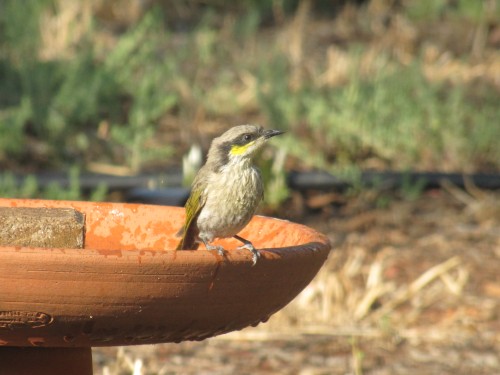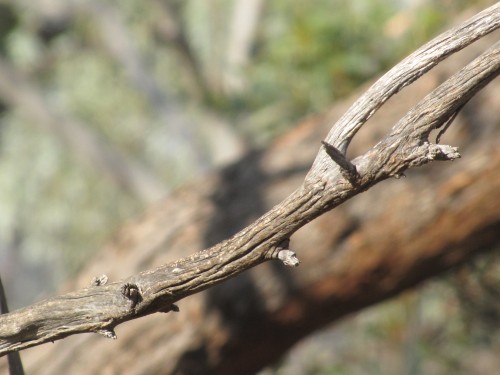Singing Honeyeater at the bird bath
Over recent days I have shared some of the photos of birds seen during our recent hot spells of weather. Our bird baths are popular with the resident bird population and we can observe anything up to a dozen species in a ten minute period. Bird Bath Central can get both busy – and noisy.
One of the quieter species to come for a drink would have to be the Singing Honeyeater. They come individually – and occasionally in twos and threes – and never make a great fuss. certainly not like the gregarious New Holland Honeyeaters. I have observed that they tend to come when no other birds are around. The much larger Red Wattlebirds and Australian Magpies are the usual dominant birds, bossing the other species away.
And then we get those interesting birds like that not shown in the photo below. Sometimes the birds are just too quick for my camera. I must make a collection of photos of rocks, twigs, branches and fence posts showing where a bird has just been – but escaped before the shutter was released.
New Holland Honeyeaters
Last week we went for a short picnic lunch to the Pangarinda Arboretum at Wellington East, South Australia.
The breeze was cool – it is winter after all – but the sun was pleasant if you were out of the wind. While we had our lunch about half a dozen Welcome swallows entertained us by swooping all around. Two of them seemed to be having a race (breeding behaviour?) and as they swept past me they nearly collided with my nose.
While there were plenty of plants already flowering this spot will only come into its own in the coming month of so. Many plants were not yet flowering. Despite that the birds were already busy feeding on those plant that were in flower. The New Holland Honeyeaters, Red Wattlebirds and Singing Honeyeaters were particularly active everywhere through the park. We only stayed several hours but it was a pleasant diversion from the intense writing I have been doing over the last few weeks.
Singing Honeyeaters and native plants
The Singing Honeyeater is a common species in suitable habitat throughout much of Australia. It tends to be absent only from the eastern coastal areas, most of Victoria (except the south coast), and the far north of Queensland and the Northern Territory. It’s preferred habitats include mallee scrubs, mulga, roadside vegetation, orchards, vineyards and gardens. It tends to be rather solitary in habit. On occasions I have seen small loose flocks of up to four or five birds, usually where the vegetation is dense, for example, coastal dunes.
Resident Breeding species
The Singing Honeyeater is a resident breeding species in our garden. Their numbers never seem to go over about four or five on our 2 hectare (5 acre) block of land. The dominant plant species is mallee scrub (click here for a photo). They were perhaps more numerous more than ten years ago, but in recent times the New Holland Honeyeaters have become the dominant – and very bossy – species.
Updated November 2013
Eremophila glabra
The resident Singing Honeyeaters are regular visitors to our bird baths. I don’t think I’ve seen them actually bathing in the water; they just tend to come for a drink. Next to the bird bath is a sprawling bush called Eremophila glabra. In the photo this plant has the bright red tube-shaped flowers. (Click on the photo to enlarge). The honeyeaters frequently stay for five minutes or more feeding on these flowers. A quick return trip to the water for a drink and then they are off to feed elsewhere.
Dripper systems
In the photo you will observe a black hose in front of the bird. This is part of our watering system. We have installed many hundreds of metres of similar hoses throughout our garden and orchard. Wherever there is a plant we place a dripper. Each dripper then allows a steady stream of drips to the plant when the tap is turned on. We have timers on each tap which then turn off the water to the dripper hoses after a set time, usually one or two hours.
Severe drought
Many Australian gardeners have recently moved to this system because of the severe drought we are experiencing. Many areas are on severe water restrictions. In some places you cannot even use dripper systems like this one. We have certainly done our bit to conserve water because we’ve been using drippers for over 20 years. Most people are only installing them now.
Plants in our garden
For more photos and information about the plants in our garden and in our district go to Mallee Native Plants Nursery, my wife’s blog about our beautiful Australian plants.






